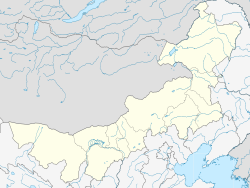
Back بايان أوبو Arabic Bayan Obo (lungsod sa Pangmasang Republika sa Tśina, Inner Mongolia Autonomous Region, lat 41,77, long 109,97) CEB Bayan Obo German Bayan Obo Mining barrutia Basque District minier de Baiyun French Bayan Obo Italian バヤンオボー鉱区 Japanese 바이윈어보 광구 Korean Bayan Obo Polish Баян-Обо Russian
Bayan'obo
白云鄂博矿区 • ᠪᠠᠶᠠᠨ ᠣᠪᠣᠭ᠋ᠠ ᠠᠭᠤᠷᠬᠠᠢ ᠶᠢᠨ ᠲᠣᠭᠣᠷᠢᠭ | |
|---|---|
 Bayan Obo, 2006 false color ASTER image by NASA | |
 Location in Baotou | |
| Coordinates: 41°46′58″N 109°58′25″E / 41.78278°N 109.97361°E | |
| Country | China |
| Autonomous region | Inner Mongolia |
| Prefecture-level city | Baotou |
| District seat | Tongyang Road Subdistrict |
| Area | |
| • Total | 247.89 km2 (95.71 sq mi) |
| Population (2020)[1] | |
| • Total | 22,681 |
| • Density | 91/km2 (240/sq mi) |
| Time zone | UTC+8 (China Standard) |
| Website | www |
| Bayan Obo Mining District | |||||||
|---|---|---|---|---|---|---|---|
| Chinese name | |||||||
| Simplified Chinese | 白云鄂博矿区 | ||||||
| Traditional Chinese | 白雲鄂博礦區 | ||||||
| Literal meaning | rich ovoo mining district | ||||||
| |||||||
| Mongolian name | |||||||
| Mongolian Cyrillic | Баян-Овоо Уурхайн дүүрэг | ||||||
| Mongolian script | ᠪᠠᠶᠠᠨ ᠣᠪᠣᠭ᠋ᠠ ᠠᠭᠤᠷᠬᠠᠢ ᠶᠢᠨ ᠲᠣᠭᠣᠷᠢᠭ | ||||||
| |||||||
Bayan'obo Mining District (Mongolian: ᠪᠠᠶᠠᠨ ᠣᠪᠣᠭ᠋ᠠ ᠠᠭᠤᠷᠬᠠᠢ ᠶᠢᠨ ᠲᠣᠭᠣᠷᠢᠭ, Chinese: 白云鄂博矿区), or Baiyun-Obo or Baiyun'ebo, is a mining district in the west of Inner Mongolia, China. It is under the administration of Baotou City, the downtown of which is more than 120 kilometres (75 mi) to the south.
The mines north of the town are the largest deposits of rare-earth elements yet found and, as of 2005, responsible for 45% of global rare-earth element production.[2][3][4]
In the satellite image at right, vegetation appears red, grassland is light brown, rocks are black, and water surfaces are green. Two circular open-pit mines are visible, as well as a number of tailings ponds and tailings piles.[5]
- ^ Inner Mongolia: Prefectures, Cities, Districts and Counties
- ^ Lawrence J. Drewa, Meng Qingrunb and Sun Weijun (1990). "The Bayan Obo iron-rare-earth-niobium deposits, Inner Mongolia, China". Lithos. 26 (1–2): 43–65. doi:10.1016/0024-4937(90)90040-8.
- ^ Xue-Ming Yang, Michael J. Le Bas (2004). "Chemical compositions of carbonate minerals from Bayan Obo, Inner Mongolia, China: implications for petrogenesis". Lithos. 72 (1–2): 97–116. doi:10.1016/j.lithos.2003.09.002.
- ^ Chengyu Wu (2007). "Bayan Obo Controversy: Carbonatites versus Iron Oxide-Cu-Au-(REE-U)". Resource Geology. 58 (4): 348–354. doi:10.1111/j.1751-3928.2008.00069.x. Archived from the original on 2012-12-17.
- ^ NASA Bayan Obo image and writeup

